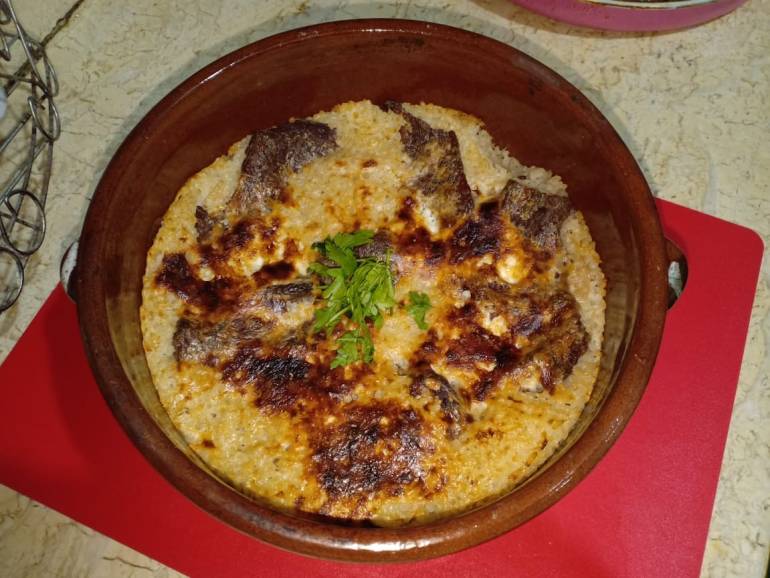The Egyptian sign has a special taste, a delicacy of Egyptian rice drenched in the gravy of the meat, lying on top of toasted bread, and decorated with a mixture of tomatoes to which garlic and vinegar splash is added, a delicious aroma that penetrates the hungry stomachs' forts, and some believe that the Egyptians knew the crumb with the Islamic conquest, because meat and porridge It is not a well-known Egyptian heritage that relied on botanical recipes such as beans, lentils, and molokhia.
But the inscriptions of the Subic Temple refer to the story of the young girl in the Pharaonic history, so that the Egyptian priestess Kara slaughtered a sheep, brimming it with bulgur, onions and eggplant, and "crumbling" the pieces of bread in it, adding onions, garlic and vinegar and submerging it in broth, and then distributed it to visitors to the Temple of God, in Eid day to bless idol.
The Egyptians knew "Fattah" since ancient times, and occupy a distinguished place on their tables on the occasion of Eid al-Adha, with liver dishes, mombars, shapes and different ways of preparing meat, but the fattah remains the original dish with a taste that does not compete with anything.
The Egyptian gesture differs from its counterparts in the Arab countries, it is not like the Syrian gesture or the Arab push, but the difference is not only between the Arab countries, but the eaters of the first day of Eid al-Adha differ in its name and composition even within Egypt.
Kashim, baskets, and Nubian jakkud
While the butcher finishes slaughtering the sacrifice and healing the flesh, the Nubian lady takes the first piece of meat that comes out of the sacrifice, and makes kashid from it, which is the main dish for the people of Nubia on the morning of the feast, and it consists of small pieces of meat, with the addition of pieces of liver, lung and tripe (the bowels of the sacrifice) , Stirred with a large amount of onions, and spices eaten dipped in bread "douka".
And the Nubian Fattah, differs from its counterparts in the rest of Egypt, it is lunch for the first day, which is a soup and rice with solar bread, and added to it a plate of jacob, which is a mixture of dried molokhia and dried okra, and bread and spinach also dried, with coriander leaves and fennel Green with gravy, which is a vegetable gesture par excellence, and contains all the proteins and vitamins of the meat, and added to them a special Nubian seasoning that adds a different flavor to the taste of the broth.
As for the baskets, it is a lamb dish that is served to the guests on the feast of the day adjacent to the gesture, which is roast beef on top of zalat and stones.
Al-Taqeqish: Eid food in Siwa
Takagish is the ceremonial dish in the Siwa Oasis, served on Eid al-Adha and weddings, it is a sign of joy and abundant goodness, and the dish consists of sheepskin washed well after the slaughter, and it is cut into small pieces and then it is browned with pieces of liver and spleen, is served with the Siwa fattah, which is Dish rice with Siwi bread without sauce, with dried mallow dishes, dipped in meat broth and raw garlic.
Abu Mardam .. cooking on the method of drilling
Grilled lamb with yellow rice is the badia fattah as the people of Siwa and the people of Matruh and Salloum call it. On the day of Arafa the sheep is slaughtered and seasoned well, and placed on charcoal in a huge pit prepared specially for this purpose, and under charcoal hot sand, as the lamb is covered with tin leaves, and above the paper Sands intended for underground bread, and after hours the lamb comes out full ripening, served meat with steamed rice dishes and spicy soup without sauce.
Tucked
Tucked, which is durable rice, and it is called tucked because meat is placed inside the rice in a large casserole and added to them milk and cream, and with it tortoise submerged in broth and butter, the people of Bahri in Egypt (the coastal northern governorates) know this type of rice cooker and they celebrate it on holidays in advance of the crumb Traditional, mastered by the people of Upper Egypt, where it is the first feast for them in the joys, solace and day of the holiday alike.
Fattah is served with boiled meat over rice and bread saturated with meat broth and previously fried in natural ghee. The people of Upper Egypt do not put the sauce on top of the meat, as this is what they call "eating banders" or urban residents.

